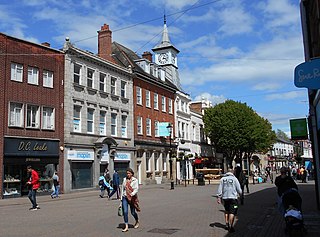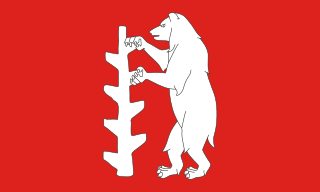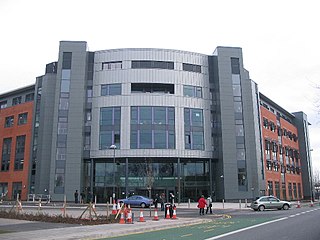
Coventry is a city, administrative centre and metropolitan borough in England and the United Kingdom. It is built on the River Sherbourne, which remains largely hidden by infrastructure, although it can be seen by the canal. Coventry has been a large settlement for centuries, although it was not founded and given its city status until the Middle Ages; since then it has been one of the most important and largest cities of the country. The conurbation consists of the Coventry and Bedworth Urban Area, being the 20th largest in the country; the city is governed by Coventry City Council.

Kenilworth is a market town and civil parish in Warwickshire, England, about 6 miles (10 km) south-west of central Coventry, 5 miles (8 km) north of Warwick and 90 miles (140 km) north-west of London. It lies on Finham Brook, a tributary of the River Sowe, which joins the River Avon about 2 miles (3 km) north-east of the town centre. The 2011 Census recorded a parish population of 22,413. The town is noted architecturally for the extensive ruins of Kenilworth Castle, the ruins of Kenilworth Abbey in Abbey Fields park, St Nicholas's Parish Church, and the town's clock tower.

Royal Leamington Spa, commonly known as Leamington Spa or simply Leamington, is a spa town in Warwickshire, England. Originally a small village called Leamington Priors, it grew into a spa town in the 18th century following the popularisation of its water which was reputed to have medicinal qualities. In the 19th century, the town experienced one of the most rapid expansions in England. It is named after the River Leam, which flows through the town.

Nuneaton is a large town in northern Warwickshire, England. The population in 2011 was 86,552, making it the largest town in Warwickshire.

Warwick is a market town and county town of Warwickshire, England. It lies near the River Avon, 11 miles (18 km) south of Coventry and west of Leamington Spa and Whitnash. Its population was 31,345 in 2011. Signs of Neolithic activity precede unbroken habitation to the 6th century AD. It was a Saxon burh in the 9th century; Warwick Castle was built during the Norman conquest of England. Warwick School claims to be the country's oldest boys' school. The earldom of Warwick, created in 1088, controlled the town and built its walls, of which Eastgate and Westgate survive. The castle became a fortress, then a mansion. The Great Fire of Warwick in 1694 destroyed much of the town. Warwick missed industrialisation, but the population has grown almost sixfold since 1801.

The West Midlands is one of nine official regions of England at the first level of NUTS for statistical purposes. It covers the western half of the area traditionally known as the Midlands. It contains Birmingham and the larger West Midlands conurbation, which is the third most populous in the United Kingdom. The City of Coventry is also located within the West Midlands county, but is separated from the conurbation to the west by several miles of green belt. The region also contains 6 shire counties which stretch from the Welsh Border to the East Midlands.

Warwickshire is a county in the West Midlands region of England. The county town is Warwick, and the largest town is Nuneaton. The county is famous for being the birthplace of William Shakespeare.

Warwick is a local government district of central Warwickshire in England. The current leader of the district council is Conservative Party member Andrew Day. The council is currently in no overall control, but the Conservatives run the administration through an agreement with the Whitnash Residents Association. Conservatives have 19 councillors, the Liberal Democrats have 9 councillors, the Green Party 8 councillors, Labour 5 Councillors with the remaining 3 councillors are part of the Whitnash Residents Association.

Coventry University is a public research university in Coventry, England. The origins of Coventry University can be traced back to the founding of the Coventry School of Design in 1843. It was known as Lanchester Polytechnic from 1970 until 1987, and then as Coventry Polytechnic until the Further and Higher Education Act 1992 afforded it university status that year and the name was changed to Coventry University.

This article is about the history of Coventry, a city in the West Midlands, England.

King Henry VIII School is a coeducational independent school located in Coventry, England, comprising a senior school and associated preparatory school. The senior school has approximately 800 pupils. The current fees stand at £12,000 per year, with bursaries and scholarships available. Due to its location close to Coventry's railway station, the school accommodates pupils from around the West Midlands area, including towns at 30 miles' distance, such as Northampton, Warwick, Balsall Common, Leamington Spa, Kenilworth, Rugby and Nuneaton.

Coventry Airport is located 3 NM south-southeast of Coventry city centre, in the village of Baginton, Warwickshire, England. The airport is operated by Coventry Airport Limited, and has a CAA Ordinary Licence that allows flights for the public transport of passengers or for flying instruction as authorised by the licensee, Coventry Airport Limited.

Herbert Art Gallery & Museum is a museum, art gallery, records archive, learning centre, media studio and creative arts facility on Jordan Well, Coventry, England.

Guy's Cliffe is a hamlet on the River Avon and the Coventry Road between Warwick and Leek Wootton in Warwickshire, England, near Old Milverton.

University Hospital Coventry is a large National Health Service (NHS) hospital situated in the Walsgrave on Sowe area of Coventry, West Midlands, England, 4 miles (6.4 km) from the city centre. It is part of the University Hospitals Coventry and Warwickshire NHS Trust, and works in partnership with the University of Warwick's Warwick Medical School. It has a large, progressive accident & emergency department providing a trauma service to Coventry and Warwickshire.
Exhall Grange Specialist School is a special school located in Ash Green just outside Coventry in Warwickshire, England. The school meets the needs of children and young people age from 2 to 19 years with physical disability, visual impairment, complex medical needs, and social, communication and interaction difficulties.

City College Coventry was a further education college based in the city of Coventry, England. It was formed in 2002 through the merger of two previous colleges in the city, although through them it has roots going back to the 19th century. It was one of three further education colleges within the city boundaries, alongside Henley College and Hereward College. The college caters for 12,000 students and occupies a purpose-built campus in the Swanswell area of Coventry. In 2017 City College merged with Henley College to form Coventry College.

Greyfriars, Coventry was a medieval monastic house in the West Midlands, England.

The buildings known as Whitefriars are the surviving fragments of a Carmelite friary founded in 1342 in Coventry, England. All that remains are the eastern cloister walk, a postern gateway in Much Park Street and the foundations of the friary church. It was initially home to a friary until the Dissolution of the Monasteries. During the 16th century it was owned by John Hales and served as King Henry VIII School, Coventry, before the school moved to St John's Hospital, Coventry. It was home to a workhouse during the 19th century. The buildings are currently used by Herbert Art Gallery and Museum, Coventry.
John Bailey Shelton MBE was a British archaeologist who worked in the city of Coventry and a pioneer of rescue archaeology.




















